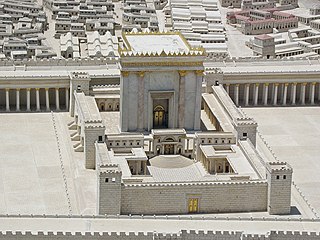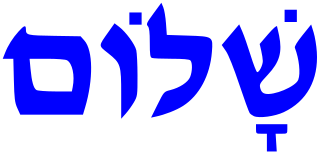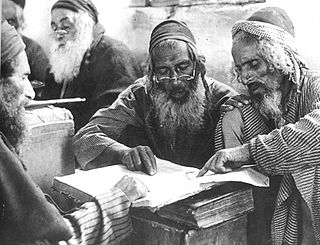Related Research Articles

The Talmud is the central text of Rabbinic Judaism and the primary source of Jewish religious law (halakha) and Jewish theology. Until the advent of modernity, in nearly all Jewish communities, the Talmud was the centerpiece of Jewish cultural life and was foundational to "all Jewish thought and aspirations", serving also as "the guide for the daily life" of Jews.

Rabbinic literature, in its broadest sense, is the entire spectrum of rabbinic writings throughout Jewish history. However, the term often refers specifically to literature from the Talmudic era, as opposed to medieval and modern rabbinic writings, and thus corresponds with the Hebrew term Sifrut Chazal. This more specific sense of "Rabbinic literature"—referring to the Talmudim, Midrashim, and related writings, but hardly ever to later texts—is how the term is generally intended when used in contemporary academic writing. The terms mefareshim and parshanim (commentaries/commentators) almost always refer to later, post-Talmudic writers of rabbinic glosses on Biblical and Talmudic texts.

The Second Temple, later known as Herod's Temple, was the reconstructed Temple in Jerusalem between c. 516 BCE and 70 CE. Defining the Second Temple period, it stood as a pivotal symbol of Jewish identity and was central to Second Temple Judaism; it was the chief place of worship, ritual sacrifice (korban), and communal gathering for Jews. As such, it attracted Jewish pilgrims from distant lands during the Three Pilgrimage Festivals: Passover, Shavuot, and Sukkot.
ArtScroll is an imprint of translations, books and commentaries from an Orthodox Jewish perspective published by Mesorah Publications, Ltd., a publishing company based in Rahway, New Jersey. Rabbi Nosson Scherman is the general editor.
Shalom aleichem is a greeting in the Hebrew language. When someone is greeted with these words, the appropriate response is aleichem shalom. The term aleichem is plural, but is still used when addressing one person.

Shalom is a Hebrew word meaning peace and can be used idiomatically to mean hello.

Yemenite Hebrew, also referred to as Temani Hebrew, is the pronunciation system for Hebrew traditionally used by Yemenite Jews. Yemenite Hebrew has been studied by language scholars, many of whom believe it retains older phonetic and grammatical features lost elsewhere. Yemenite speakers of Hebrew have garnered considerable praise from language purists because of their use of grammatical features from classical Hebrew.
According to Rabbinic Judaism, the Oral Torah or Oral Law are statutes and legal interpretations that were not recorded in the Five Books of Moses, the Written Torah, and which are regarded by Orthodox Jews as prescriptive and given at the same time. This holistic Jewish code of conduct encompasses a wide swathe of rituals, worship practices, God–man and interpersonal relationships, from dietary laws to Sabbath and festival observance to marital relations, agricultural practices, and civil claims and damages.
Savora is a term used in Jewish law and history to signify one among the leading rabbis living from the end of period of the Amoraim to the beginning of the Geonim. As a group they are also referred to as the Rabbeinu Sevorai or Rabanan Saborai, and may have played a large role in giving the Talmud its current structure. Modern scholars also use the plural term Stammaim for the authors of unattributed statements in the Gemara.

Pesachim, also spelled Pesahim, is the third tractate of Seder Moed of the Mishnah and of the Talmud. The tractate discusses the topics related to the Jewish holiday of Passover, and the Passover sacrifice, both called "Pesach" in Hebrew. The tractate deals with the laws of matza and maror, the prohibitions against owning or consuming chametz (leaven) on the festival, the details of the Paschal lamb that used to be offered at the Temple in Jerusalem, the order of the feast on the first evening of the holiday known as the Passover seder, and the laws of the supplemental "Second Pesach".
Shalom bayit is the Jewish religious concept of domestic harmony and good relations between husband and wife. In a Jewish court of law, shalom bayit is the Hebrew term for marital reconciliation.

Berakhot is the first tractate of Seder Zeraim of the Mishnah and of the Talmud. The tractate discusses the rules of prayers, particularly the Shema and the Amidah, and blessings for various circumstances.

Seder Olam Rabbah is a 2nd-century CE Hebrew language chronology detailing the dates of biblical events from creation to Alexander the Great's conquest of Persia. It adds no stories beyond what is in the biblical text, and addresses such questions as the age of Isaac at his binding and the number of years that Joshua led the Israelites. Tradition considers it to have been written about 160 CE by Jose ben Halafta, but it was probably also supplemented and edited at a later period.
The primary texts of Kabbalah were allegedly once part of an ongoing oral tradition. The written texts are obscure and difficult for readers who are unfamiliar with Jewish spirituality which assumes extensive knowledge of the Tanakh, Midrash and halakha.
Jewish Palestinian Aramaic or Jewish Western Aramaic was a Western Aramaic language spoken by the Jews during the Classic Era in Judea and the Levant, specifically in Hasmonean, Herodian and Roman Judaea and adjacent lands in the late first millennium BCE, and later in Syria Palaestina and Palaestina Secunda in the early first millennium CE. This language is sometimes called Galilean Aramaic, although that term more specifically refers to its Galilean dialect.
Abba is a form of ab, meaning "father" in many Semitic languages. It is used as a given name, but was also used as a title or honorific for religious scholars or leaders.
Sura Academy was a Jewish yeshiva located in Sura in what is now southern Iraq, a region known in Jewish texts as "Babylonia". With Pumbedita Academy, it was one of the two major Jewish academies from the year 225 CE at the beginning of the era of the Amora sages until 1033 CE at the end of the era of the Gaonim. Sura Academy was founded by the Amora Abba Arikha ("Rav"), a disciple of Judah ha-Nasi. Among the well-known sages that headed the yeshiva were Rav Huna, Rav Chisda, Rav Ashi, Yehudai ben Nahman, Natronai ben Hilai, Saadia Gaon, and others.

Tumtum is a term that appears in Jewish Rabbinic literature. It usually refers to a person whose sex is unknown because their genitalia are hidden, undeveloped, or difficult to determine.
Simon, son of Boethus was a Jewish High priest in the 1st century BCE and father-in-law of Herod the Great. According to Josephus, he was also known by the name Cantheras. His family is believed to have been connected to the school of the Boethusians, and a family whose origins are from Alexandria in Egypt.
The Oven of Akhnai is a Talmudic story found in Bava Metzia 59a-b which is set around the early 2nd century CE. In the Talmud, the story is told after a discussion of being careful not to mistreat a person and the power of prayers which are said in pain to be heard by God. The story concerns a debate which was held over the halakhic status of a new type of oven. In the course of the rabbinic disagreement, the story expresses differing views of the nature of law and authority, concerns over a fractured and divisive community, and the issue of harming another person through words and actions.
References
- 1 2 Tallan, Emily Taitz, Sondra Henry, Cheryl (2003). The JPS guide to Jewish women : 600 B.C.E.-1900 C.E. (1st ed.). Philadelphia: Jewish Publication Society. ISBN 0827607520.
{{cite book}}: CS1 maint: multiple names: authors list (link) - ↑ Brayer, Menachem M. (1986). The Jewish woman in rabbinic literature. Hoboken, NJ: Ktav Pub. House. ISBN 0881250724.
- ↑ Rubenstein, Jeffrey L. (2003). Talmudic stories : narrative art, composition, and culture. Baltimore, Md.: Johns Hopkins University Press. ISBN 0801877547.
- ↑ Ilan, Tal (1997). "The Quest for the Historical Beruriah, Rachel, and Imma Shalom". AJS Review. 22 (1): 1–17. doi:10.1017/S036400940000920X. S2CID 161285734.